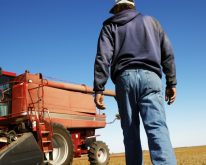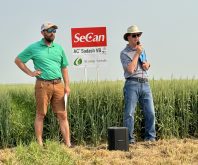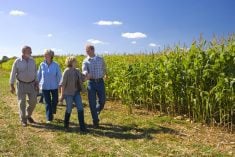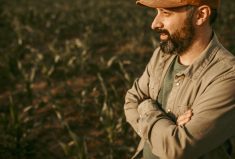When Ontario’s Janet O’Rourke and her husband Kevin took CTEAM — the executive management program designed specifically for Canadian farmers and ranchers — they got their first taste of peer feedback and the benefits it can bring. As part of the program, their class of farmers met four times over two years and got to really know and trust each other. They dug into each other’s farms through a series of business planning tasks and presentations, they analyzed each other’s plans and looked at their opportunities, and they shared a huge stockpile of accumulated experience.
As it happens, it didn’t end when they graduated. In fact, there still isn’t any end in sight.
A year after completing the program, O’Rourke opened her mailbox and found her new issue of Country Guide. There, posed on the cover, were her CTEAM classmates Brooks and Jen White from Manitoba.
The February 2018 story was all about the White’s own journey through the program, and how other farmers in the course had helped shape the future direction of their own crop and bison operation.
Next steps
What caught O’Rourke’s attention, in particular, was that the Whites had also found another way to keep the peer evaluation experience going: Brooks White had joined an innovative regional peer-group initiative led by Terry Betker of Backswath Management Inc.
Read Also

Youth motivated to find answers to today’s agricultural challenges
This is the first in a series of articles exploring the perspectives and experiences of young people who are finding…
“I read that and just became really interested in the whole concept of peer review,” O’Rourke says. In fact, her interest inspired her to reach out to the other Ontario farmers from her CTEAM class to ask if they’d be interested in forming their own peer group.
Three of them said yes, so O’Rourke, who farms crops, hogs and poultry near Dublin, Ont., contacted White to learn more about the inner workings of his group, and also reached out to CTEAM principal instructor Larry Martin. “I told Larry what we wanted to do, and I asked him how we should start. We had four interested farms but I didn’t know how to organize this and was hoping he could point me towards someone who could help,” she says.
Martin was enthusiastic too. He had endorsed the peer group concept for many years but hadn’t actually had a chance to work in one from the inside.
Getting started
Martin knew of two other farms that were also interested in joining, and together with O’Rourke, that added up to a group of six couples keen to learn from each other.
Since everyone in the group had previously taken CTEAM, they started off with similar backgrounds in management training and were all using written business plans.
They were also comfortable sharing information about their business in a group setting because it’s something they had done during the course, which Martin characterizes as a unique environment built on trust.
“People are usually concerned about sharing during the first session, and it’s a natural thing to hold everything close to your chest, especially in agriculture,” he says of his experience with CTEAM.
When a new group starts CTEAM, Martin asks participants to share their financial ratios but does not require them to share their numbers. After a few sessions together, he finds almost everyone shares their numbers with the group because they have listened to each other’s stories and built trust.
“Your financials are right up there on the overhead screen,” O’Rourke says of the peer group presentations. “Everything is on the table and it’s totally confidential.”
Martin warns that members of a peer group should farm far enough away from each other that they don’t consider themselves neighbours (“It doesn’t work very well when you’re trying to get into real depth talking about your business strategy in front of the people you might be competing with,” he explains) but close enough that they can meet in-person fairly easily.
In O’Rourke’s group, five farms are within two hours of each other in southern Ontario and one is farther east. Some may consider this too close for comfort but because they operate in a variety of sectors, it works well. The range of commodities represented by the group — crops, poultry, processing vegetables, sheep, sod and swine — just goes to show that the focus is business management, not production.
How it works
Each member pays a fee and the group meets twice per year for a one-day session facilitated by Martin.
Every session includes what he calls the “check-in” — a significant portion of the day spent discussing each business. The host farm and two others present detailed information about their business while the other three give a quick update. Members rotate through these positions in future sessions so everyone has the opportunity to host the group within two years.
“We review our business plan, what we have accomplished since the last meeting and what we plan to do before the next one,” says O’Rourke. She adds that every couple has the opportunity to ask the group for advice or help with what they are working on.
When it’s your turn to share more details, Martin says the conversation gets deeper. “They share pros and cons and more detailed information about their business. The idea is that the group gets deeper into critiquing and discusses what they can do differently and how they can improve.”
New learnings
Most sessions also include education on a selected topic. “At a very high level, they decide what they want to learn about, and my job is to bring in the resources,” Martin says of his role as facilitator. As a past agriculture economics professor, it’s second nature for him to bring new information to the group and suggest readings for further study.
Past topics have included financial ratio analysis, input and commodity pricing, staffing issues, leadership, strategies for working with family, and effective communication.
Organization is key
Strong organization is critical to the success of the group. The Covid-19 pandemic has led to temporary changes, but the goal is that each session has an agenda and ends with making plans for the following meeting. The group uses text messaging and email if they need to communicate between sessions.
During their third time together, Martin led members through the process of creating a charter. It outlines who is involved, why they are in it, what they want to get out of it and what behaviour would cause them to be removed.
The process encouraged members to be open and honest about their intentions. As a result, Martin learned more about what the group wanted from him and each other. “They were really clear that they are not paying me to be nice to them. They do not want things sugar-coated because they want to learn and be as good as they can be. They want the rest of the group to be very critical of them,” he says.
Looking back, he is glad they took a couple of sessions to get to know each other before creating the charter. “I think having clarity in terms of where we want to go as an organization is important. When they agreed they didn’t want anyone holding back on criticism, that took us a bit deeper.”
Shared benefits
For members, each session is a reminder of why they’re involved. O’Rourke says travelling, discussing six farm businesses and taking in new information makes for a busy day but everyone agrees it is worth it.
The group enables her and her husband to try ideas on their farm that other members are using now or have tried in the past. “The ideas don’t always work for our situation but we are open to anything that could improve what we are currently doing. It’s a collaborative effort and we all benefit,” she says.
Thanks to peer group learnings, the O’Rourkes now analyze financial ratios on an annual basis, they have implemented new strategies around input pricing, and they have adopted standard operating procedures and job descriptions.
From a business planning perspective, group members also hold each other accountable for keeping their written document up to date.
After writing a business plan for the first time, it’s up to the individual whether it stays a living document or gets added to the filing cabinet.
For O’Rourke, the peer group is how she keeps her document alive. “I review and update our plan twice per year to prepare for the next session,” she says. Without that structure she knows it would eventually fall off the priority list, especially during busy seasons.
O’Rourke and her peers are practical people and good managers. Martin jokes that it is a challenge to stay ahead of them but knows they wouldn’t be involved almost three years later if it wasn’t valuable.
Martin believes there is potential for farmers to get great value out of peer groups and thinks they are becoming more common across Canada. “It only takes one good idea from one other member at one session to make it pay off,” he says.
















